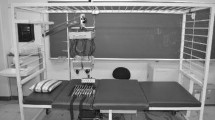Abstract
Potential distributions of electrocardiogram (ECG) on the body surface had already been drawn schematically with the isopotential lines supposing an electromotive force of the heart as the single dipole in as early as 1888 by Waller [19]. However, for its practical application in a clinical environment a computer was indispensable to collect electrocardiographic signals from numerous spots on the body surface and to process them to derive isopotential contour lines. This has developed in accordance with progress of the computer technology [11, 12]. Particularly in the 1970’s a clinically applicable system was devised as a result of the advanced development of microcomputers. Here we take as an example the most frequently used mapping system in Japan, developed by us, and discribe its outlines as well as its application to experimental studies and clinical examinations.
Access this chapter
Tax calculation will be finalised at checkout
Purchases are for personal use only
Preview
Unable to display preview. Download preview PDF.
Similar content being viewed by others
References
Flowers NC, Horan LG, Sohi GS, Hand RC, Johnson JG: New evidence for infero-posterior myocardial infarction on surface potential maps. Am J Cardiol 38: 576–581, 1976.
Fox KM, Selwyn A, Oakley D, Shillingford JP: Relation between the precordial projection of S-T segment changes after exercise and coronary angiographie findings. Am J Cardiol 44: 1068–1075, 1979.
Fujino T: On genesis of RBBB pattern in electro-and vectorcardiogram as studied by simulation of ventricular propagation process and reconstruction of ORS patterns. Jap Circ J 32: 1533–1541. 1968.
Hayashi H, Ishikawa T, Uematsu H, Takami K, Kojima H, Yabe S, Ohsugi S: Identification of the site of origin of ventricular premature beats by body surface map in patients with or without cardiac disease. In: Yamada K, Harumi K, Musha T (eds) Advances in body surface potential mapping. Nagoya, The University of Nagoya Press. 1983, pp 257–264.
Horan LG, Flowers NC, Johnson JC: Significance of the diagnostic Q wave in myocardial infarction. Circulation 43: 428–436, 1971.
Koike Y: Correlation between areas of ventricular pre-excitation and types of WPW QRS patterns by means of computer simulation of ventricular activation sequence. Jap Heart J 18: 462–472, 1977.
Kubota I, Watanabe Y, Tsuiki K, Yasui S: Body surface distribution of exercise-induced ST depression in patients with angina pectoris. Jap Heart J 24: 853–862, 1983.
Mirvis DM: Body surface distributions of repolarization potentials after acute myocardial infarction. II. Relationship between isopotential mapping and ST segment potential summation methods. Circulation 63: 623–631, 1981.
Niimi N. Sugiyama S, Wada M, Sugenoya J. Oguri H, Toyama S, Okajima M, Yamada K: Genesis of body surface potential distribution in right bundle branch block. J Electrocardiology 10: 257–266, 1977.
Ohta T, Kinoshita A, Ohsugi J, Isomura S, Takatsu F, Ishikawa H, Toyama J, Nagaya T, Yamada K: Correlation between body surface isopotential map and left vcntriculograms in patients with old inferoposterior myocardial infarction. Am Heart J 104: 1262–1270, 1982.
Okajima M, Fujino T, Kobayashi T, Yamada K: Cc mputer simulation of the propagation process in excitation of the ventricles. Circ Res 23: 203–211, 1968.
Okajima M, Doniwa K, Ishikawa T, Niimi N, Koike Y: On body surface VAT ‘isochrone’ maps generated by computer using simulated excitation sequences in ventricular model. Comp in Cardiol, IEEE Computer Society, 1980.
Spach MS, Barr RC: Ventricular intramural and epicardial potential distributions during ventricular activation and re-polarization in the intact dog. Circ Res 37: 243–257, 1975.
Sugiyama S, Wada M, Sugenoya J, Toyoshima H, Toyama J, Yamada K: Experimental study of myocardial infarction through the use of body surface isopotential maps: Ligation of the anterior descending branch of the left coronary artery. Am Heart J 93: 51–59, 1977.
Taccardi B: Distribution of heart potentials on the thoracic surface of normal human subjects. Circ Res 12: 341–352, 1963.
Tatematsu H, Wada M, Okajima M, Yamada K On-line conversational mode processing system for body surface mapping. Adv in Cardiol 10: 20–25, Karger, Basel. 1974.
Tonooka J, Kubota I, Watanabe Y, Tsuiki K, Yasui S: Isointegral analysis of body surface maps for the assessment of location and size of myocardial infarction. Am J Cardiol 52: 1174–1180, 1983.
Toyama J, Ohta Y, Yamada K: Newly developed body surface mapping system for clinical use. In: Yamada K. Harumi K, Musha T (eds) Advances in body surface potential mapping. Nagoya, The University of Nagoya Press, 1983, pp 125–133.
Waller AD: The electromotive properties of the human heart. Brit Med J 2: 751–754, 1888.
Watanabe T, Toyama J, Toyoshima H, Oguri H, Ohno M, Ohta T, Okajima M, Naito Y, Yamada K: A practical microcomputer-based mapping system for body surface, precordium and epicardium. Computers and Biomed Res 14: 341–354, 1981.
Yamada K, Toyama J, Wada M, Sugiyama S, Sugenoya J, Toyoshima H, Mizuno Y, Sotohata I, Kobayashi T, Okajima M: Body surface isopotential mapping in Wolff-Parkinson-White syndrome. Non-invasive method to determine the localization of the accessory atrio“entricular pathway. Am Heart J 90: 721–734, 1975.
Author information
Authors and Affiliations
Editor information
Editors and Affiliations
Rights and permissions
Copyright information
© 1987 Martinus Nijhoff Publishers, Boston
About this chapter
Cite this chapter
Doniwa, K., Kawaguchi, T., Okajima, M. (1987). Body surface potential mapping — its application to animal experiments and clinical examinations. In: Atsumi, K., Kajiya, F., Tsuji, T., Tsujioka, K. (eds) Medical Progress through Technology. Springer, Dordrecht. https://doi.org/10.1007/978-94-009-3361-3_11
Download citation
DOI: https://doi.org/10.1007/978-94-009-3361-3_11
Publisher Name: Springer, Dordrecht
Print ISBN: 978-0-89838-973-9
Online ISBN: 978-94-009-3361-3
eBook Packages: Springer Book Archive




